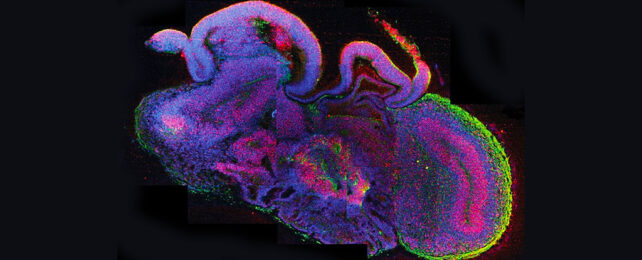Our body's organs are complex, 3D structures made up of a variety of tissue types, all interacting to fill a specific role in keeping us alive.
To understand how they develop, function, and sometimes fail, scientists are often forced to study them in a preserved state, long after they've stopped growing.
That's all changing, with advances in a new kind of biological model; the organoid.
What are organoids?
Organoids are small, simplified, 3D copies of organs created outside of a living body, usually grown by treating combinations of tissues or stem cells with the nutrients and chemical signals (growth factors) that encourage them to differentiate and self-organize.
Typically ranging in size from the width of a hair to a few millimeters (a fraction of an inch) across, these replicas fall well short of carrying out the full array of functions of the original organ; but depending on how they're designed, they can break down and churn out similar materials and even grow in stages that mimic what they do within an actual body.
How do organoids work?
Organoids tend to be developed with the purpose of studying specific characteristics of the target organ that can't be seen so easily in an animal model, giving researchers greater control over functioning tissues in isolation of a living body and allowing them to closely observe specific changes and sequences of development.
While researchers have been encouraging complex arrangements of tissue to grow in lab equipment outside of the body in cultures since at least the early 20th century, advances in stem cell research has allowed researchers to create conditions in the laboratory that more closelt mimic those inside a changing body.
By 2006 scientists had successfully created a version of a tiny, vascularized liver in glassware that continued to function for around two months. A wide variety of these stem-cell derived organoids soon emerged, providing insights into the development and functions of parts of intestines, kidneys, heart, eyes, and even brains.
Could we grow whole organs this way?
Organoids are currently used as a tool to investigate development of diseases such as cancer or neurological conditions, or influences of various growth factors, impacts of other chemicals (both toxic and therapeutic).
As the complexity of organs increases and subtle influences of chemistry and physical proximity to other tissues and organs rises, the ability to mimic the organ's development becomes ever harder. Without the integration of an immune system and appropriate spread of blood vessels, for example, few will grow into the right shapes or adopt the right structures. Lack of nutrient supplies through blood vessels also limits their size.
These challenges limit both the depth of studies we can carry out on organoids and our ability to ever use them as organ substitutes.
What we learn about organoid development could in theory be used to improve the creation of transplantable tissues in the future. Already researchers are finding ways to overcome limitations through developing work-arounds, growing organoids separately before combining them or using lattices to provide frames that give tissues their shape.
Are brain organoids ethical?
Growing hairy layers of skin tissue or a metabolizing slither of liver in a Petri dish might make some people uncomfortable, but it's only with the beating of organoid cardiac tissue or the impulses generated by an organoid cerebral cortex that ethics comes to mind.
The ethics of growing brain organoids is slowly attracting the kind of attention once devoted solely to questions of embryonic development. When is the activity of nervous tissue 'human' enough?
On one hand, organoids provide much needed insight into models of neurological development to allow us better understand conditions such as Alzheimer's disease or autism.
Yet where they follow a tendency to reflect an actual embryonic nervous system, or even flicker with the kinds of waves we might see in an emerging brain, there is overlap with philosophical and moral concerns over the definition of personal autonomy.
All Explainers are determined by fact checkers to be correct and relevant at the time of publishing. Text and images may be altered, removed, or added to as an editorial decision to keep information current.
